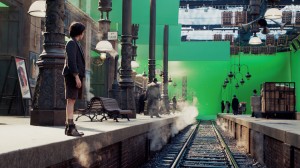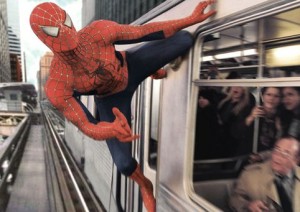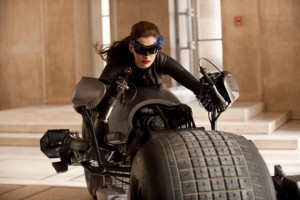Visual Effects (VFX) Emmy Winners
VFX Dominate the Best Movies
LOS ANGELES, July 26, 2012, Robert Goldrich —

There’s a welcomed bit of deja vu for several nominees in the 2012 prime time Emmy competition for best visual effects, all against the backdrop of this being the first year of reconfigured categories recognizing artistic excellence in the discipline. The change is akin to what the Visual Effects Society (VES) Awards have already had firmly in place–a category distinction between VFX-driven programs and those in which VFX play a supporting role.
In this installment of “The Road To Emmy,” SHOOT connects with visual effects nominees behind episodes of Boardwalk Empire, Falling Skies and Once Upon A Time as well as the movie Hemingway & Gellhorn. These artisans discuss their work as well as the newly created primetime Emmy categories for VFX. But first, we review these two categories–Outstanding Special Visual Effects, and Outstanding Special Visual Effects in a Supporting Role.
According to Academy of Television Arts & Sciences (ATAS) language describing the

Outstanding Special Visual Effects category, eligible nominees are effects-driven programs where VFX are routinely present and essential to the storytelling–shows which could not have been realized without the inclusion of VFX. Programs in this category could include shows dealing with space travel, the supernatural, creatures, fantasy themes, superhero powers and/or CG or puppeteered creatures, etc., and have extensive use of computer graphics, virtual sets (environments which are created almost entirely in computer and could include performers shot on green screen), and large-scale pyrotechnic and mechanical special effects.
Meanwhile, the Emmy category Outstanding Special Visual Effects in a Supporting Role honors the overall achievement of VFX in programs where those effects are used on a more modest scale, play a supporting role contributing to the storytelling, and are often photorealistic and invisible to the viewer. A supporting role may include set extensions (the creation, enhancement or augmentation of a practical location or physical set), sky replacements, atmospheric phenomenon, scientific visualizations, crowd replication, fire, smoke, elemental enhancement, and similar effects. Such effects are used more sparingly to help create the setting, environment or mood of a given scene, or to illustrate a scientific principle–but the program does not absolutely require the use of special visual effects to tell the story.
Prior to this year, there were two VFX primetime Emmy categories based on the

program format, not the role or nature of the effects themselves. Those now replaced VFX categories were: one for long-form projects which had TV movies competing with miniseries; the other for all ongoing series spanning genres from sci-fi to more straight live-action storytelling. The revamping of these categories was sparked in part by the diminishing presence of long-form fare on TV. So this year, series competed directly with miniseries and TV movies for nominations in the two redefined primetime Emmy VFX categories.
A different path for Boardwalk
The alluded to deja vu with a decided twist given the new Emmy VFX categories hits home first-hand for Brooklyn, N.Y.-based Brainstorm Digital which last year saw its artists win the Emmy for Outstanding Special Visual Effects for a Series on the strength of the pilot for Boardwalk Empire on HBO. Now in 2012, Brainstorm Digital talent is again nominated for Boardwalk Empire–this time for the “Georgia Peaches” episode and in the new Outstanding Visual Effects in a Supporting Role category.
“For me, it made a lot of sense for the Television Academy to set up the two categories this way like the VES,” said Richard Friedlander, co-founder/partner in Brainstorm Digital and VFX producer for the studio on Boardwalk Empire. “Effects work that’s invisible–that doesn’t put on a show so to speak–should not be competing with a more obvious visual effects usage such as in sci-fi where it plays a primary role in the story. We won the Emmy last year even though we were up against much more visual effects-driven projects. Now with the new categories, we’re not competing against a show like Game of Thrones [HBO], which has effects that are more spectacular in nature.”
Still, Brainstorm Digital deliberated and borderline agonized over which episode of Boardwalk Empire to enter into this year’s Emmy competition for consideration. After consulting with the show’s producers and getting their perspectives, Brainstorm opted for “Georgia Peaches” over another episode which featured intricate CG face work. For “Georgia Peaches,” Brainstorm had a greater variety of effects accomplishments, transforming a Brooklyn location into Hoboken, NJ, in the 1920s, and pulling that off for a riot sequence depicting African-Americans demonstrating in a public protest and being attacked by Irish thugs. “With the cameras constantly moving in the riot or rumble sequence, our ‘invisible’ effects work becomes more challenging,” Friedlander noted.
Friedlander conjectured that if a series isn’t in a pilot year, then VFX studios should be allowed to submit work from a couple of episodes–currently no more than one episode of a series can be entered into competition. “The advantage we had last year,” he explained, “is that we entered the pilot [for Boardwalk Empire]. Usually twice the amount of money is spent on the pilot and there’s a variety of effects work. In the subsequent season, you have variety but it’s spread out over two or three episodes–each episode focuses on a different component in the series. Being able to enter more than one episode of a show would be my main suggestion to the TV Academy but you have to take these things one step at a time. The move they made this year to have a Supporting Role category represents a big step forward.”
Twice as nice
Meanwhile the effects ensemble at Zoic Studios, Culver City, Calif., and Vancouver, B.C., earned two 2012 Emmy nominations, both in the Outstanding Special Visual Effects category–one for the “Live and Learn” episode of Falling Skies (TNT), the other for “The Stranger” episode of Once Upon A Time (ABC). This marks the fourth time in the past five years that Zoic artisans have scored at least one VFX Emmy nomination (two noms apiece in three of those years). Zoic was nominated in 2010 for Ben 10: Alien Swarm and the series V; in ’09 for the series Fringe; and in ’08 for the series Jericho and Terminator: The Sarah Connor Chronicles.
During that stretch, Zoic tallied 11 VES Award nominations, including winning for Outstanding Supporting Visual Effects in a Broadcast Program on the basis of Fringe in ’09.
Andrew Orloff, co-founder/executive creative director of Zoic and visual effects supervisor on this year’s nominated episodes of Falling Skies and Once Upon A Time, is gratified by his studio’s 2012 noms. “This is truly recognition from your peers the way the Emmy nomination selection process works. Other visual effects supervisors who do the kind of work we do, the people you work and compete against, decide by putting our craft first and setting our competing aside. This kind of recognition from your peers is a great honor.”
Making that honor even more special is that it’s for two series that represent a wide range of VFX artistry. “Normally in broadcast, a little bit of the selection process is based on certain techniques or genres,” related Orloff. “Some places do great virtual set or matte painting work. Others do great character work. Others do great ‘hard surface’ work like planes, trains, automobiles. To have two shows that span all that stuff earn Emmy nominations means a lot to us.”
For instance, on Falling Skies, Zoic collaborates with noted creature and character designers to develop the look, movement and performance of the alien characters that play such a large role in the show. Zoic creates CG characters and uses motion capture technology to bring to life a wide range of creatures. “To be involved in a process where we get notes from [executive producer] Steven Spielberg [DreamWorks Television] with his suggestions for the characters is a dream come true. To have an alien character performing against Noah Wyle in a scene while making sure that the post-apocalyptic environment and the spaceships are right reflects the different ways in which we contribute to the series.”
Similarly multi-faceted in terms of spanning varied VFX disciplines from CG characters to virtual environment work, Once Upon A Time centers on a small town where the magic and mystique of fairy tales could indeed be real. Additionally, Zoic deploys its proprietary pre-visualization process Z.E.U.S. (Zoic Environmental Unification System) on the show. The process combines the benefits of real-time compositing with an integrated editorial and CG pipeline. Z.E.U.S. provides real-time camera tracking and rendering of the virtual environments on set, bringing creative flexibility for the cast and crew working on the green screen stage. This technology provides Orloff and the Zoic team with the real-time feedback needed to deliver film quality effects on a TV budget and schedule.
Orloff noted, for example, that having Once Upon A Time nominated in the same category as made-for-cable series like Game of Thrones with generally more lead time and deeper pocket budgets speaks well for what Zoic was able to accomplish within broadcast series time and financial constraints. “We’re delivering episodes on the same time frame as a broadcast series like Desperate Housewives but with 500 visual effects shots added,” he said.
Earlier this year Orloff relocated from Southern California to Vancouver to help in the development of the Zoic complex there which underwent a recent build-out and nearly doubled its size and capacity. Zoic has realized its vision to have two full-fledged studios–Culver City and Vancouver–working together. “I wasn’t interested in making a satellite/outsourcing office in Vancouver,” said Orloff. “We want both our facilities to be full service, creative, and to have the Zoic culture, the same creative DNA individually and when collaborating with one another.”
Both Falling Skies and Once Upon A Time are shot in Vancouver. According to Orloff, the primary Zoic teams on both series consist of artisans pretty much equally divided between the Culver City and Vancouver studios.
Orloff is a proponent of the Emmy Awards’ newly fashioned VFX categories. “Great environmental or invisible effects work being done on shows like Boardwalk Empire and Bones can get overshadowed by huge sci-fi shows with intensive effects. The separate mainstream heavy effects and supporting categories put visual effects work on a more level playing field in competition. There’s more of a place in the supporting category for shows like Breaking Bad which you don’t normally think of for visual effects work.”
At the same time, Orloff affirmed that the TV Academy needs to be vigilant in that there’s gray area on a number of projects when it comes to differentiating between supporting and featured visual effects. Those shows have to be scrutinized to make sure they are fairly competing in the proper category.
Hemingway & Gellhorn
For Tippett Studio to experience deja vu relative to an Emmy nomination, one has to have a good memory. This year, artists at the Berkeley, Calif.-based studio earned a nod in the Outstanding Visual Effects in a Supporting Role category on the basis of its work for Hemingway & Gellhorn (HBO). This marks Tippett’s first Emmy nomination in VFX since 1986 when it won for Ewoks: Battle for Endor. Tippett also won an Emmy in ’85 for Dinosaur.
Chris Morley, visual effects supervisor at Tippett and on Hemingway & Gelhorn, said of the Emmy nomination, “It’s exciting to be recognized. But after two year on this project, I really don’t think too much about awards. It’s definitely a bonus to receive such an honor yet for me it’s more about the creative and problem solving process. I love the craft.”
Morley also likes the new Emmy categories for VFX. Of the Supporting Role designation, he observed, “There are many invisible effects out there as opposed to spectacular effects that everyone can clearly identify as effects–creatures, dragons, space travel. To recognize both supporting and leading visual effects with their own categories is wonderful. Visual effects are being used so much nowadays to help tell stories and they often go unnoticed. Actually being unnoticed in the show is the goal–that’s a craft in and of itself.”
Among the examples of the invisible effects in Hemingway & Gellhorn, Morley cited adding palm trees to Bay Area settings to make the locales look more like Cuba, and a shot in which Martha Gellhorn (played by Nicole Kidman) gets out of a car and walks into Finca Vigia, Ernest Hemingway’s home in Cuba. That scene was lensed in three separate locations–(stairs and foreground) at a Catholic school in Northern California’s Marin County, on a set (doorway) built on Treasure Island in the Bay Area, and an image (of the home’s facade) captured by Morley in Cuba. Tippett put all these elements together in a matte painting.
There are more visible visual effects in Hemingway & Gellhorn as well. “One of the first challenges was bringing director Philip Kaufman up to speed as to what can be done utilizing visual effects. He has been at the forefront of thinking outside the box. He used a lot of stock footage in The Right Stuff for example–and then in The Unbearable Lightness of Being, where there was stock footage coupled with shooting reverse angles. Walter Murch cut that work together seamlessly. For Hemingway & Gellhorn, we worked on a third angle, placing actors inside the footage. We experimented a year before principal photography, looking at archival footage, picking plates, going out as a small rag-tag team and shooting all these tests. We had a locations manager stand in for Hemingway, an archival footage lady stand in for Gellhorn. We did some composites and showed Phil, opening up a new creative world of possibilities for him–which at the same time we had to reign in because of the fairly modest budget being in TV and not feature films. We all had to think creatively.”
Morley also cited the efforts of Tippett cameramatch move supervisor Chris Paizis who used computerized cameras to line up angles of the archival footage and then match those angles on set to have “perfect perspective.” This and other creative applications helped to put, said Morley, “the suspension of disbelief into play…You see Clive Owen [as Hemingway] and Nicole Kidman with FDR, and through a suspension of disbelief, the audience finds the scene clever, fun and charming.”
